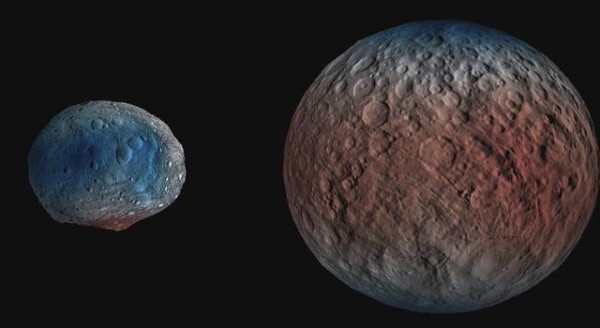By Ana Verayo, | December 18, 2016

NASA's Dawn spacecraft has determined the hydrogen content of the upper yard, or meter, of Ceres' surface. (NASA/JPL-Caltech/UCLA/MPS/DLR/IDA/PSI)
The mysterious dwarf planet Ceres has mesmerized us with its bright spots, which were apparently salt deposits glistening from its upper crust. Now, new data from NASA's Dawn spacecraft reveals that Ceres possesses volcanoes erupting with ice and mud and is filled with hidden water.
Like Us on Facebook
New findings indicate the presence of these cryovolcanoes on the surface of Ceres, nestled at the bottom of its large craters. Additional data also suggests that Ceres is filled with ice underneath its surface that also covers its craters. These new findings were presented during a meeting of the American Geophysical Union.
According to Ralf Jaumann of the German Aerospace Center, the Dawn mission science team expected a lot and were completely surprised.
Ceres is the biggest body in the asteroid belt between Mars and Jupiter. NASA's Dawn spacecraft became the first spacecraft to ever visit this region in 2015.
With the help of Dawn's camera, the surface of Ceres revealed several craters that are covered with material similar to lava flows. However, this lava appears to be less viscous than other volcano emissions elsewhere in the solar system, Jaumann added.
What is even more surprising is that this lava flow on Ceres is the same color as a mountain on the planet, slightly tinged with blue, made from ice mixed with mud.
The team suggests that this cryovolcanic material is a mixture of not just ice and mud but also salt that was exposed during asteroid and meteor impacts on Ceres.
Jaumann and his team's findings were published in the journal Geophysical Research Letters.
These volcanoes are not yet confirmed. However, additional observations of Ceres also reveal that the dwarf planet is encapsulated in ice, formed from something similar to water.
Within the craters lie dark hollows where sunlight never reaches. The bottom of the craters reach frigid temperatures of around 350 degrees below zero, said the co-author of the study, Thomas Platz from the Max Planck Institute for Solar System Research.
Plats and his team's findings were published in the journal Nature Astronomy.
Dawn also detected that Ceres is hiding vast ice deposits underneath its upper soil layer, according to Thomas Prettyman of the Planetary Science Institute. His team has suggested that these ice levels will return to liquid water at some point.
These new findings were published in the journal, Science.
-
Use of Coronavirus Pandemic Drones Raises Privacy Concerns: Drones Spread Fear, Local Officials Say

-
Coronavirus Hampers The Delivery Of Lockheed Martin F-35 Stealth Fighters For 2020

-
Instagram Speeds Up Plans to Add Account Memorialization Feature Due to COVID-19 Deaths

-
NASA: Perseverance Plans to Bring 'Mars Rock' to Earth in 2031

-
600 Dead And 3,000 In The Hospital as Iranians Believed Drinking High-Concentrations of Alcohol Can Cure The Coronavirus

-
600 Dead And 3,000 In The Hospital as Iranians Believed Drinking High-Concentrations of Alcohol Can Cure The Coronavirus

-
COVID-19: Doctors, Nurses Use Virtual Reality to Learn New Skills in Treating Coronavirus Patients







